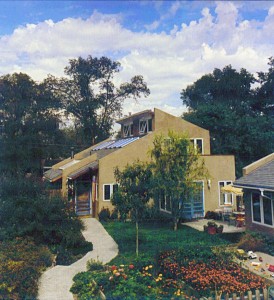 The traditional passive solar homes designed in the 1970s and 80s were usually designed with a long (east/west) axis facing south or slightly southeast (in the northern hemisphere). They worked because in winter, when the sun tracks lower in the sky, sunlight shines directly through the south facing glass, heating up the spaces within. Thermal mass, such as masonry floors, trombe walls or barrels of water act like a battery and absorb extra heat from the air during the day. At night, when the air temperature cools, this thermal mass radiates heat into the room, keeping the indoor temperature more stable and comfortable.
The traditional passive solar homes designed in the 1970s and 80s were usually designed with a long (east/west) axis facing south or slightly southeast (in the northern hemisphere). They worked because in winter, when the sun tracks lower in the sky, sunlight shines directly through the south facing glass, heating up the spaces within. Thermal mass, such as masonry floors, trombe walls or barrels of water act like a battery and absorb extra heat from the air during the day. At night, when the air temperature cools, this thermal mass radiates heat into the room, keeping the indoor temperature more stable and comfortable.
These homes are called passive solar because there are no mechanical systems used… no moving parts. It’s just sun shining through windows to supply additional heat in the colder winter months.
Thermal mass is an expensive and difficult item to build into a home and for this reason some of the early passive solar homes lacked in thermal mass. This resulted in homes that got too hot in the daytime and too cold at night. Word got around that passive solar design was flawed and this scared many casual enthusiasts away. Then after the solar tax credits expired, many solar businesses failed and passive solar design fell out of favor. Fortunately, Sunlight Homes carried on through this dry spell with enough customers who believed in passive solar design to keep us in business, honing the art and craft of custom passive solar residential design.
Winter Heating + Summer Cooling in a Passive Solar Home
In the winter in North America, the sun’s arc is low is the south sky so the sun shines into south facing windows for most of the day. Thermal mass inside naturally absorbs the solar heat, then in the evening when the air inside cools, the stored solar energy in the thermal mass warms the home overnight. In the summertime, the path of the sun is high in the sky, so it passes overhead and only shines into east or west facing windows when it rises and sets. Correctly-sized roof overhangs, in our passive solar house designs, shade windows from the hot summer sun. They are particularly effective in spring and fall when the sun is a little lower in the sky and the temperatures are warmer. In a well designed and built passive solar home, good insulation, high efficiency windows and thermal mass keep indoor temperatures more stable and comfortable year-round.
Notice the shadow in the Summer Solstice photograph, taken on June 21st, the longest day of the year. The windows face south and the sun is high in the sky. The roof overhang is sized to shade the windows in the summer to eliminate solar heat gain into the home. The Winter Solstice photograph, taken on December 21st, the shortest day of the year, shows how low the sun is in the winter sky. The overhang lets maximum solar thermal energy into the home during the winter when it’s needed. Different climates and latitudes have their own climate-related design needs.
Trombe Walls
Old style passive solar houses were often designed with trombe (rhymes with mom) walls which are south-facing, solid masonry walls built about 6 inches behind south facing windows. Trombe walls absorb solar heat during the day and release heat into the room at night when the air temperatures inside drop. Trombe walls are often painted black to increase heat absorption. The down side of Trombe walls is that, since they are walls, they reduce the home’s exposure to natural day lighting. Also, larger footings are necessary to support the weight and with the added labor and materials, Trombe walls are expensive to build. Plus, it’s almost impossible to design a “pretty” trombe wall.
Clerestory Windows
Clerestory (CLEAR-story) windows are another design feature in traditional solar homes. Since the windows are built up high, above the line of sight and into the roof/ceiling, you can usually only see the sky and the tops of tall trees when you’re inside, but it is a thrill! Clerestories bring south light and warmth into north rooms. Clerestories cost more, but in the right application, it’s worth the expense. They have a distinctive architectural style, too, that must be integrated into the design of the home. Clerestories remain an effective strategy for certain design passive solar home design situations and have stood the test of time.
The Down Side of Traditional Passive Solar
While traditional solar house designs were energy efficient, if designed correctly, we found (after designing and building them for years) that they had their down sides. Original solar house designs had a lot of floor to ceiling south-facing windows (and few if any windows on the north side of the home). In the winter, when the sun is lower in the sky, these south-facing rooms were often too sunny! Furniture had to be arranged carefully around the sunlight and upholstery often faded. These homes were prone to overheating in spring and fall, especially if their overhangs weren’t sized correctly, or if builders skimped on the (expensive) thermal mass. Extreme window placement (with none on the north wall) posed an aesthetic problem. Perhaps the biggest obstacles in these first solar house designs were that many people found the architectural style unattractive. The function limited the form a little too much. These homes, with all their mass and glass, were also expensive to build.
Green Residential Design Today
Today things have changed. Technology has improved windows, SIPs, and PV solar electric. Experience and innovation has improved solar house design and construction so those who decide to ‘go solar’ today will reap the benefits of the years of trial and error and of the technological innovation that has developed over the last several decades. It makes much more sense financially, now that energy prices are higher and rising, to utilize one of the greatest, free resources we have… the power of the sun.
